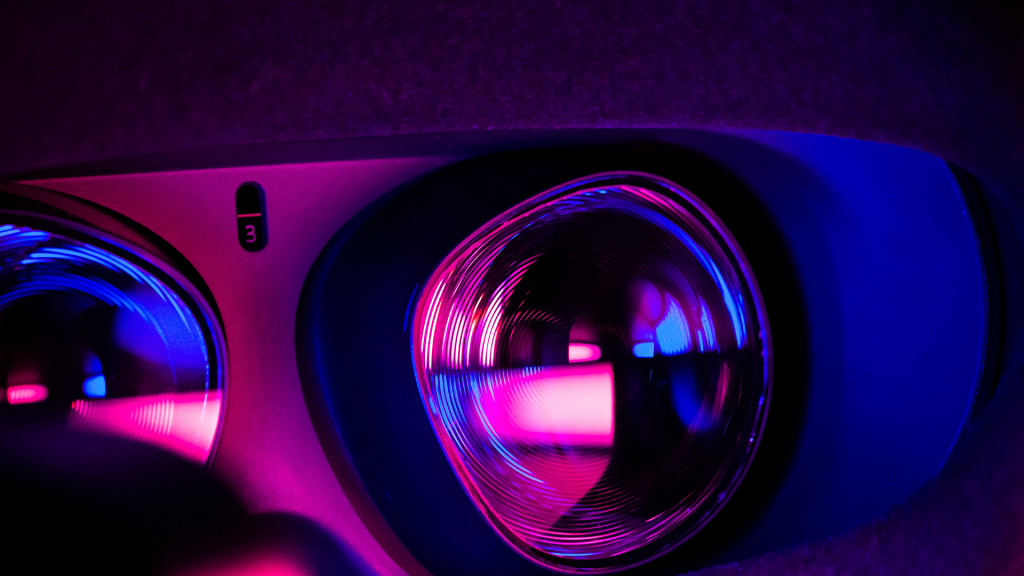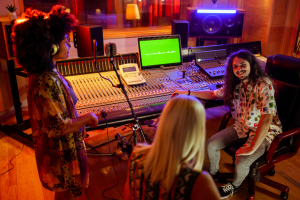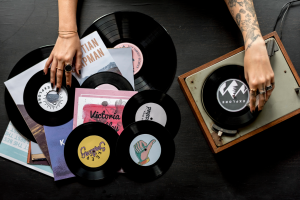In the realm of music and sound, we are constantly exploring new frontiers. One such frontier that is rapidly gaining traction is the intersection of music and virtual reality (VR). As technology evolves, so does our ability to create and consume art in innovative ways. This evolution has brought us to the precipice of a new era, where music and VR converge to create immersive soundscapes.
Immersive soundscapes refer to auditory environments or sound fields that completely envelop the listener. Unlike traditional sound design, which often relies on a fixed number of channels, immersive soundscapes can come from any direction, and even move around within a three-dimensional space. This dynamic audio experience, when combined with the visual immersion offered by VR, opens up a whole new world of possibilities for artists and audiences alike.
The importance of discussing this intersection lies in its potential to revolutionize the way we create, perform, and experience music. It’s not just about listening to music anymore; it’s about stepping inside it, interacting with it, and experiencing it in a way that was previously unimaginable.
Understanding Immersive Soundscapes
Immersive soundscapes are a new frontier in auditory experiences. They go beyond the traditional stereo or surround sound systems, offering a three-dimensional sonic environment that envelops the listener. This means that sound can come from above, below, behind, or move around, creating a much more realistic and engaging listening experience.
At its core, immersive sound is about creating a sense of space and presence within the audio experience. It’s about simulating the way we naturally perceive sound in real life. When combined with the visual immersion of VR, it creates an incredibly lifelike and compelling virtual reality experience.
Creating immersive soundscapes requires both creative and technical skills. Musicians and sound designers need to consider not just the composition of the music, but also how it moves and behaves within a three-dimensional space. This includes factors like the direction, distance, speed, and even the size of the sound source.
Unlike traditional sound design, which often uses a fixed number of channels (like stereo’s two channels), immersive soundscapes can have virtually unlimited channels. This allows for a more flexible and dynamic audio experience. For example, in a VR concert, you could have the sound of the main performer coming directly in front of you, the crowd cheering all around you, and even the subtle echoes bouncing off the virtual walls and ceiling.
Immersive soundscapes offer a whole new level of interaction and engagement with music. They provide a deeper, more nuanced audio experience, where the listener is not just a passive recipient, but an active participant in the sonic environment. In the following sections, we’ll explore how this innovative approach to sound is being used in the world of VR and what it means for the future of music.
The Evolution of Music and Sound in Virtual Reality
Music and sound have always been integral to virtual reality experiences. They serve as powerful tools to enhance immersion, evoke emotions, and guide user interactions within the virtual environment. However, the way we use music and sound in VR has evolved significantly over the years.
In the early days of VR, the focus was primarily on visual fidelity – creating realistic, three-dimensional graphics. Audio often took a backseat, with most VR experiences using standard stereo or surround sound formats. While these provided a certain level of immersion, they were limited by their lack of spatial accuracy and realism.
The advent of technologies like binaural audio and ambisonics brought a new dimension to VR sound design. Binaural audio simulates the way we hear sounds in real life, taking into account factors like the shape of our ears and the distance between them. This results in a much more lifelike and immersive audio experience, especially when wearing headphones.
Ambisonics, on the other hand, is a full-sphere surround sound technique that allows for sound to come from any direction in a 3D space. It’s particularly well-suited to VR, as it allows for dynamic, real-time changes in sound direction, which can match the user’s head movements.
In recent years, we’ve seen a growing interest in creating music specifically for VR. Artists and producers are beginning to explore the unique possibilities that VR offers, from interactive music videos where users can influence the narrative, to virtual concerts where fans can experience a live performance from the comfort of their own home.
Furthermore, the introduction of spatial audio in platforms like Facebook’s Oculus VR has opened up even more opportunities for immersive music experiences. Spatial audio allows for precise positioning of sounds in a 3D space, enabling artists to create intricate soundscapes that react to the user’s movements and interactions.
As VR technology continues to advance, and as more artists and creators embrace this medium, we can expect to see even more innovative uses of music and sound in the virtual realm. The evolution of music and sound in VR is far from over; in fact, it’s just getting started.
The Impact of VR on Music Production
Virtual reality is not only reshaping how we experience music but also how we create it. As VR becomes more accessible and widespread, musicians and producers are exploring new ways to leverage this technology in music production.
One of the most significant impacts of VR on music production is the shift towards spatial audio. Traditional music production often focuses on a stereo mix, where sounds are positioned within a left-right spectrum. However, VR demands a more complex approach, with sounds coming from all directions in a three-dimensional space. This requires new techniques and tools for sound recording, mixing, and mastering.
Several software developers have already started to address these needs by creating VR-specific audio production tools. These tools allow musicians and producers to manipulate sounds within a 3D space, adding depth and dimension to their compositions. For example, tools like DearVR and Facebook’s Spatial Workstation offer intuitive interfaces for designing and positioning sounds in a virtual environment.
Moreover, VR can serve as an innovative platform for musical creativity and experimentation. Musicians can use VR to compose music in entirely new ways, such as creating virtual instruments that can be played with VR controllers or using motion tracking to convert physical movements into musical notes.
VR also offers new possibilities for collaboration. With shared virtual spaces, musicians located in different parts of the world can come together to jam, compose, and perform in real-time. This could potentially revolutionize the way musicians collaborate, breaking down geographical barriers and fostering global musical connections.
Finally, VR opens up new avenues for monetization for artists. Virtual concerts, for instance, can reach a global audience, providing a valuable revenue stream, especially in times when traditional live performances may not be possible.
While the adoption of VR in music production presents a steep learning curve and requires investment in new equipment and skills, the potential rewards are immense. The immersive and interactive nature of VR offers a unique platform for musical innovation, pushing the boundaries of what is possible in music production.
Exploration of VR Musical Experiences
Virtual reality has not only transformed music production but also the ways we experience music. With VR, we can participate in immersive musical journeys that are both visually stunning and sonically profound. Let’s explore some of the innovative VR musical experiences that are available today.
- VR Concerts: One of the most popular applications of VR in music is virtual concerts. Artists like Billie Eilish, Jean-Michel Jarre, and Travis Scott have already performed in virtual spaces, allowing fans from around the world to experience their live performances in an immersive environment. These concerts often go beyond a simple replication of a traditional concert experience, offering interactive elements and visuals that can only be achieved in a virtual setting.
- Interactive Music Videos: VR also offers a new medium for music videos. Instead of being a passive viewer, you can step into the music video and interact with the environment. This adds a new layer of engagement, as your actions can influence the narrative or visuals of the video. An example is “Chained To The Rhythm” by Katy Perry, which was released as a 360-degree interactive video.
- Music Creation Tools: VR technology has led to the development of apps and tools that allow users to create their own music in an intuitive and immersive way. Apps like SoundStage VR and Electronauts enable users to play virtual instruments, mix tracks, and even perform live DJ sets within a VR environment.
- Music Therapy: Some researchers and therapists are exploring the use of VR as a tool for music therapy. By combining immersive visuals with carefully curated music, they aim to evoke certain emotions or responses that can aid in therapy. For example, the VR app ‘Healium’ uses biometric data to create personalized music and visuals designed to reduce stress and anxiety.
- Music Education: VR can also be a powerful tool for music education. Virtual reality music apps can provide interactive lessons, simulate different instruments, and even offer virtual practice rooms. This could revolutionize music education, making it more accessible and engaging.
These examples illustrate the diverse range of possible VR musical experiences. As technology continues to advance, we can expect to see even more innovative and immersive musical experiences in the virtual realm.
The Future of Music and Virtual Reality
As we continue to push the boundaries of technology and creativity, the intersection of music and virtual reality promises exciting possibilities for the future. Here are a few predictions and emerging trends that could shape the next chapter in this evolving narrative:
- More Immersive Concert Experiences: As VR technology continues to evolve, we can expect more immersive and interactive concert experiences. Artists might create entire virtual worlds for their performances, with fans able to explore these environments, interact with each other, and even influence the performance itself.
- Holophonic Sound: Advances in audio technology could lead to wider adoption of holophonic sound – a recording technique that creates a three-dimensional auditory experience. This could make VR music experiences even more immersive, making it feel like the sound is coming from all around and even moving within the virtual space.
- AI-Generated Music: Artificial Intelligence is already being used to create music, and this technology could play a significant role in VR music experiences. AI could be used to generate adaptive soundtracks that respond to the user’s actions or emotions in real time, creating a uniquely personalized musical experience.
- Physical-Digital Integration: The integration of physical and digital elements could add another layer of immersion to VR music experiences. This could involve haptic feedback devices that let you ‘feel’ the music, or mixed reality performances that blend live action with virtual elements.
- Accessibility and Inclusion: VR has the potential to make music more accessible and inclusive. For example, people with disabilities could attend virtual concerts without the logistical challenges of a physical event. Also, VR music tools could provide an accessible way for anyone to create music, regardless of their musical background or skills.
- New Revenue Streams for Artists: As the music industry continues to navigate the digital age, VR could provide new revenue streams for artists. This could include ticket sales for virtual concerts, monetization of VR music apps, or licensing of music for VR experiences.
While these predictions offer a glimpse into the potential future of music and VR, the reality is likely to be even more exciting and unexpected. One thing is for sure: as technology and creativity continue to intersect in new and innovative ways, the future of music and virtual reality looks incredibly promising.
Conclusion
The intersection of music and virtual reality is a rapidly evolving frontier, offering a new realm of possibilities for artists, producers, and listeners alike. From immersive concerts and interactive music videos to innovative music creation tools and therapeutic applications, VR is reshaping the ways we create, experience, and engage with music.
As we look to the future, we can expect even more exciting developments at this intersection. Advances in technology and creativity will continue to push the boundaries of what is possible, leading to more immersive, personalized, and inclusive musical experiences.
If you’re an artist or producer looking to distribute your music and reach a global audience, sign up for a free account at Novecore. With Novecore, you can easily distribute your music to all major platforms, helping you connect with listeners around the world.
The future of music is here, and it’s virtual. Are you ready to be a part of it?



